 BES – Battle Encoder Shirase 1.3.8
BES – Battle Encoder Shirase 1.3.8for Windows XP/2000
 BES – Battle Encoder Shirase 1.3.8
BES – Battle Encoder Shirase 1.3.8
Free software that controls per-process CPU usage. “Active” software CPU cooler.
http://mion.faireal.net/BES/
Nothing fancy. It just throttles CPU-hungry applications when asked. I made it simply because I really needed it myself. (Other free software by me.) The non‐Unicode build in the same zip might work on Windows ME, but not on Windows 98.
Some external sites in other languages that explain how to use BES:
![]() BES : un limiteur de charge CPU pour quand il fait trop chaud pour travailler ....
BES : un limiteur de charge CPU pour quand il fait trop chaud pour travailler ....
![]() cpu占用率100%的解决办法,
两种方法教你如何降低cpu占用率,
降低游戏CPU使用工具
cpu占用率100%的解决办法,
两种方法教你如何降低cpu占用率,
降低游戏CPU使用工具
![]() Battle Encoder ShiraseでCPU負荷率を操作して快適なPCライフを!!,
CPUの利用率制限ソフト
Battle Encoder ShiraseでCPU負荷率を操作して快適なPCライフを!!,
CPUの利用率制限ソフト
![]() Ограничение загрузки процессора на процесс
Ограничение загрузки процессора на процесс
![]() [프로] 프로세스를 제어하여 CPU 의 사용량조절 프로그램 - Battle Encoder Shirase
[프로] 프로세스를 제어하여 CPU 의 사용량조절 프로그램 - Battle Encoder Shirase
Etc.
http://katiproject.info/gns3/limit-cpu-with-bes จำกัดการใช้งาน CPU ด้วย BES
(You can check the most up-to-date documents online: http://mion.faireal.net/BES/)
BES is a small tool that throttles the CPU usage for the process you “target”: for instance, you can limit the CPU usage of a process which would use CPU 100%, down to 50% (or any percentage you’d like). With this, you can use other programs comfortably while doing something CPU-intensive in the background.
By limiting the CPU load, you can also cool down your CPU immediately when it happens to get too hot. It’s an “active” software CPU cooler. Conventional soft-coolers save CPU energy by making CPU sleep when it is idle. They passively wait until CPU gets idle. BES is more aggressive: it cools CPU by making the “heating” process slow down, i.e. periodically forcing CPU to be idle for a short time. (But you should install a better hardware cooler if you often need to use BES for this purpose. Actually, the first thing you should try is to remove dust around your heat sink (See below). Active soft-cooling might be an interesting hack, but it's just a workaround after all. On the other hand, if your application uses CPU 100% meaninglessly, let BES do the job!)
Furthermore, BES can hide any windows you don’t want to be seen for some reason, without killing the process,
and restore the hidden windows again anytime you like.
BES is GPL’ed free software, distributed with (real messy) source code.
BES has a multilingual interface: menu language is switchable between Chinese, Japanese, English, etc.
When minimized, BES is sent to the system tray,
as a gray icon when idle, a red icon when active:
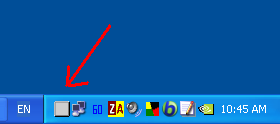
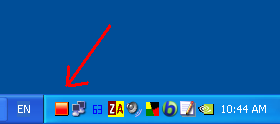
Why is it called BES or “Battle Encoder Shirase”? —There’s a long story about this weird name, but basically, it’s a parody of two anime titles: Battle Programmer Shirase and Battle Fairy Yukikaze. “Battle encoder” means a crazy person who doesn’t stop encoding even when the CPU reaches a very high temperature. BES helps them go on by cooling the CPU in a hackish way.
CPU Heat Problem? Well, I assume that some people use BES because otherwise the CPU would get too hot, even causing an emergency shutdown. If so, please first make sure that your CPU heat sink is clean enough... (Read more)
Basically, just unzip the zip wherever you like and run bes.exe. You don't need to install it. When you don't need it anymore, just delete the folder and everything will be okay (unless, of course, you put something important in BES's folder by yourself).
1.3.x builds can try to override the security system of Windows so that they can limit httpd.exe (Apache), KService.exe (Kontiki), etc. Tick the "Options | Override Security Restrictions" menu item to use the above feature. (NOTE: Use the [List all] button in the process list dialog box if the process to target is not listed by default.)
Ver. 1.3.8 2008-11-02
Various minor fixes. Some minor changes and improvements.
In case the current version doesn't work, you might want to try older versions.
Ver. 1.3.7-beta 2008-06-19
[FIX] Minor fixes.
Ver. 1.3.6-beta 2008-06-10
[FIX] possible infinite loop when trying to watch the process but the target can't be limited at all. [MOD] Other small improvements.
Ver. 1.3.5-beta 2008-05-27
[FIX] An invisible window, if iconic, was wrongly restored on "Hide"->"Show".
Ver. 1.2.2a (stable) 2007-11-22
MD5 of bes.exe 1.3.8.1 515633588A882F1D6FF4241BC36A0B64 1.3.8 2C80888B389C10D6053C2F6FBFFA6462 1.3.7-beta 4F3D54511156C67D8F341BF6C640E9D5 1.3.6-beta 0F7242F9988FA6B5B8928775D23F37AC 1.3.5-beta 3CDDC94ED653904C40240616BE6654DB 1.3.4-beta 7C86828343DB9A3250B21D5A634DE227 1.3.3-beta 599055562A0B55E39B1DCC54C43EBFC6 1.2.2a EA3C44599CAC027721F000C996CBA545

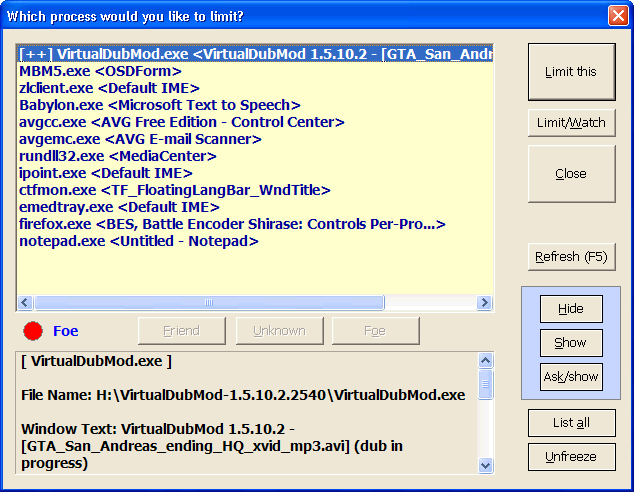
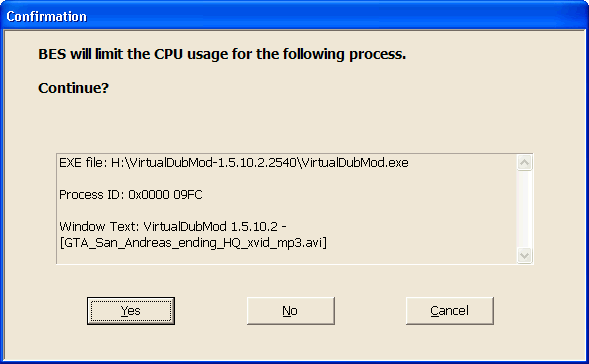
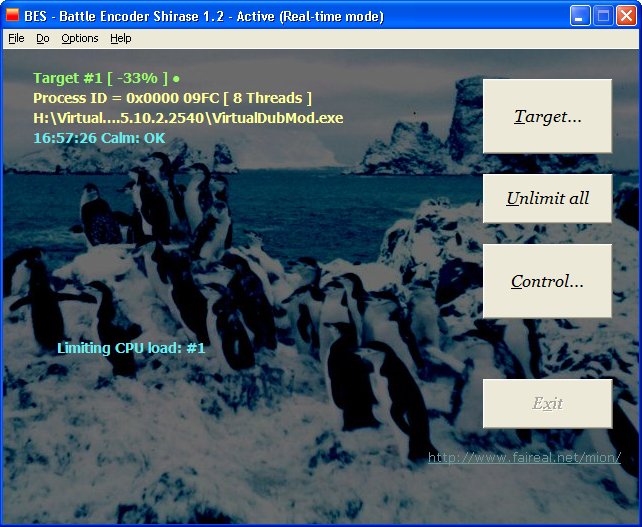
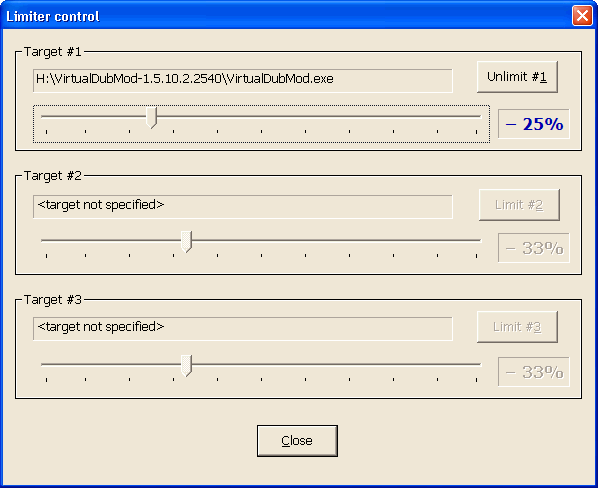

Limit & Limit/Watch: Already explained.
Close: Close this dialog.
Refresh: Refresh the list. When this dialog is opened, BES will gather the information needed to list up all the processes running. If you “refresh,” BES do the same thing again. It’s like a browse’s reload button, and is useful when a new application is started after you open this dialog (that new application will not be listed until you refresh the list).
Hide: Hide all the windows related to the selected process. The process is not killed. Just related windows will get invisible.
Show: Show the windows you hid by “Hide” if the target process is selected in the list. (In other words,
you should remember which target you hid. BES actually knows it, but (for security reason) it won’t restore the hidden windows
until you explicitly specify the target process.)
NOTE:
You can hide a running application, close BES, and restart BES after a long while.
Even if you do that, BES still remembers which windows it hid, and will restore them when you click [Show].
However, if the target ends on its own, BES can’t restore its windows (which is natural).
If you shut down or reboot the system, BES will forget about everything it hid (which makes sense too, as everything ends anyway).
Ask/show: Read the above note. Basically BES can choose the windows to restore automatically and properly. However, when something unexpected happens and things are foobared, you can manually tell BES which windows (related to the selected process) it should show. Using this, you could even force a window that is originally hidden to be shown too (some applications generate unseen windows for various reasons).
List All: The process list is usually not complete. System processes that you are not likely to target—or that you can't target, because of the security restrictions—are not listed by default. [List All] will tell BES to list everything anyway.
Unfreeze: This is just for emergency.
I bet this never happens to you, but imagine what would happen if BES crashed
just after it made the target sleep and not before it reawakened the sleeping baby
(yes, BES is a tool that periodically makes the target sleep for a very short time).
The target would then freeze.
BES is tested for a long time (from 0.8.x until 1.0 beta 18) and such a thing has never happened even once,
but in theory it could happen (you know anything weird and unexpected could happen on Windows).
Even if that happens, don't panic: restart BES, open this target dialog, go to the listbox and select the target that is frozen.
Then just click [Unfreeze].
This will reset what is called “suspend count” for each related thread, and unfreeze the application in question.
NOTE: “Unfreeze” doesn’t work if the target freezes because of its own bug and BES is not responsible.
The only situation “Unfreeze” would work is, when BES crashes itself.
As you know too well, many applications freeze/crash on their own, totally unrelated to BES.
Friend: When the item selected in the list is something that you are unlikely to target (i.e. unlikely to be CPU-intensive), you may want to tell BES that it’s CPU-friendly by clicking [Friend]. If you do that, BES recognizes the application in question as friendly, and always put it in the bottom of the list. (You can do that if you’d like to, but it is not something you must do to use BES).
Unknown: This tells BES to treat the selected item neutrally, not as Foe nor Friend.
Everything is Unknown by default.
NOTE: There are a few exceptions, such as VirtaulDub.exe. BES knows VD can be very CPU-intensive,
and always considers it as a foe (you cannot change that, as it is hard-coded).
What is meant by “VD is a foe” here, is “it may make CPU too hot.”
Nothing more than that.
It doesn’t mean VD is a bad program at all.
Foe: This tells BES to consider the selected item as Foe, i.e. a greedy application that often uses CPU too much, which BES often has to “attack.” Probably you will target the same foe again and again, possibly everyday. Once you tell BES that it’s a foe, BES automatically list it at the very top of the target list so that you can select it quickly. If you “attack” a process, that process will be automatically treated as a Foe from then on.
NOTE: The distinction between Friend, Unknown, and Foe is only in the listing order. BES will “attack” a Foe and a Friend exactly in the same way, once you order BES to target it.
Watch: This is like Limit/Watch, but using this you can target the application that is not running. BES keeps watching it, and if it is started, BES immediately begins to limit its CPU usage.
Snap: Make a detailed list of the processes currently running, and save it as a text file. Might be informative.
Exit: End the BES. You can’t exit if one or more limiters of BES are active. First unlimit all, and you can exit.
Exit anyway: End BES anyway even if it’s active. This is just for emergency, when you must end BES forcefully for some reason. BES is a babysitter that periodically lets the target sleep, and it’s a bad idea to tell it to leave without finishing its job properly. If BES is active, you should first do “Unlimit all.” (Even if told to exit anyway, BES will still try to finish its job gracefully.)
Select target / Unlimit all / Control: Already explained.
Unwatch: Use this when you want BES to stop watching the application after you tell BES to watch it.
Real-time mode: When enabled (ticked), BES demands the system to give it a very high priority (“real-time” is like telling Windows, “Hey, if I tell you to do anything, you do it right away without any delay. Don’t let me wait, okay?”). By doing so, probably BES can start as swiftly as possible even if CPU load is already near 100%. BES is a special kind of application that tries to control the CPU usage when it is already monopolized. Yet BES itself needs to get some time slices (i.e. use CPU a little) to do its job. So giving a special priority to it may make sense. Furthermore, in the real-time mode, BES will lower the process priority of the target. When disabled (unchecked), BES will behave modestly, just like an ordinary application. In reality, this usually doesn’t make any big difference.
Changed in 1.2.1: BES 1.2.1 runs as HIGH_PRIORITY_CLASS in non real-time mode index. It was NORMAL_PRIORITY_CLASS in ver. 1.2.0 and before. In real-time mode, BES gets REALTIME_PRIORITY_CLASS in every version.
Write log: Tell BES to write a debug log. Might be informative, but usually not needed, just wasting a resource.
Language: Switch the menu language.
About / Keyboard shortcuts / Visit homepage / Online help: Self-explanatory.
Ukagaka: If you have no idea, don’t bother yourself. Well, simply put, Ukagaka (→ Wikipedia: Ukagaka) is a kind of desktop mascot system. If an Ukagaka or a compatible ghost is running, BES sometimes (but quite rarely) communicates with it. For instance, when you open BES’s about box, the ghost may start chatting and tell you the version information of BES.
The following command line tells BES to watch target.exe, and—when target.exe starts running—throttle its CPU usage so that target.exe will be only allowed to use CPU (100 − percentage) % at most:
"C:\path\to\bes.exe" "D:\path to\target.exe" [percentage] [--minimize]
Optionally, you can use an integer between 1 and 99 as percentage. If percentage is omitted or invalid, the last known valid percentage for target.exe is automatically used (if this is the first time to target target.exe, the default reduction 33% will be applied, unless percentage is specified). Note that, when started from command line, BES will Watch/Limit the target, not just Limit it.
The --minimize option, available since 1.1β7, tells BES to start as minimized (sent to the system tray).
If you have any trouble, you might want to contact the author at ![]()
More generally, if you are having a hard time in your life, or if you feel really tired, take some rest and watch Floral Magician Mary Bell, especially Episodes 30–50.
Well, I assume that some people use BES because otherwise the CPU would get too hot, even causing an emergency shutdown. If so, please first make sure that your CPU heat sink is clean enough, unless your computer is a laptop or something and you cannot open the box. Usually, all you need is at most a screwdriver. Consult the instruction manual of your computer. The box may be heavy, but opening it is very easy, as long as it is supposed to open at all. No special knowledge is required. It's just a box, even though the things that are in it are complicated and delicate. Just make sure to pull the power plug and it's not hot before you open the box. Keep the removed screws in a safe place (if you remove them) and remember their correct places (or take a note), so that you can put them back later. They are tiny and tend to be missing if treated carelessly. You need to open the box and you may also need to remove some more trivial parts to see the heat sink, but don't disassemble the heat sink itself (or anything that looks complicated), unless you know exactly what you are doing.
If you find that your heat sink has gathered dust, which is very likely if you haven't cleaned it before, suck up the dust by using the vacuum cleaner carefully (you should do this periodically). Just vacuuming may be enough, but you might also want to use so-called canned compressed air. It's handy and inexpensive. First switch on your vacuum cleaner, and while sucking the air around the heat sink using your left hand, blow the dust off with canned compressed air using your right hand. This way, you can remove the dust quite completely. (If you don't have canned air, you can use your mouth at your own risk. Be careful not to spit anyway.)
Note that the gas from so-called canned air is not actually air, but some kind of toxic gas (carbon dioxide aka CO2, dimethyl ether (DME) aka methoxymethane, etc.), so use it carefully, and try not to inhale the gas. It's not that toxic (for instance, carbon dioxide is always around you anyway), but inhaling a lot in a short period is not a good idea, obviously. Also note that in some countries, they can still legally sell hydrofluorocarbon (HFC), typically difluoroethane (HFC-152a) and/or tetrafluoroethane (HFC-134a), for this purpose, but you should avoid using them. They are known to be quite strong greenhouse gases, like 100 times worse than CO2, although apparently being ozone-safe (being ozone-safe and being a greenhouse gas are two different things). Especially HFC-134a is a bad one. HFC-152a is not really good either. It's kind of idiotic and self-contradictory to heat up the Earth to solve your heat problem. It's a vicious cycle to break. At least, avoid what can be avoided. Incidentally, some products may also contain what is called a bittering agent (denatonium benzoate) for some complicated reason. Whatever the reason, this thing is VERY bitter, unbelievably, inexpressibly, ridiculously bitter, almost making you vomit instantly, so if it happens to stick to your fingers (for instance, after you air-duster your keyboard), never ever lick your fingers for any freaking reason, but just wash your hands really well. Maybe you shouldn't air-duster your cell phone either.
Canned compressed gas is convenient, but could be dangerous, it might even explode, so read the instruction before using it and keep it out of children's reach.